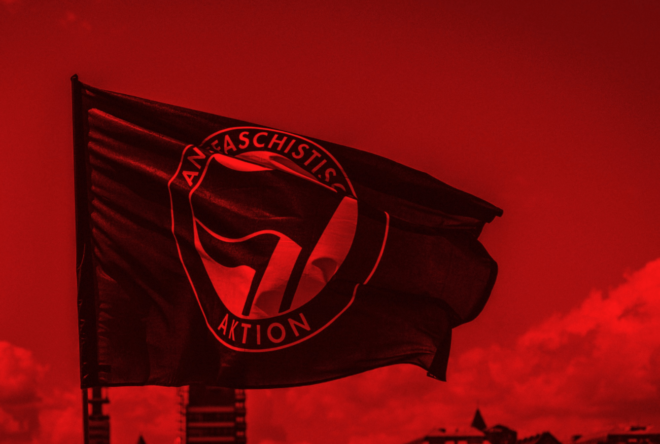Antifascister är ofta av nöd tvingade till att fokusera och agera väldigt lokalt. Det kan kan leda till att man i det vardagliga arbetet ibland glömmer bort det globala perspektivet. I ett led att lyfta blicken utåt har AFA Stockholm under hösten etablerat kontakt med flera antifascistiska grupper runt om i världen för att utbyta kunskap och inspireras av andras praktiker.
Vi har skickat ut ett antal intervjufrågor som vi själva velat ha svar på, och dessa kommer att under vintern publiceras i en rad artiklar med en gruppering i taget. Här kommer ett index av intervjuerna:
***
Anti-fascists are often forced by necessity to focus and act very locally. This can lead to people sometimes forgetting the global perspective in the everyday work. In order to look outside, AFA Stockholm has during the autumn has established contact with several anti-fascist groups around the world in order to adopt and be inspired by other practices.
We have sent out a number of interview questions to which we ourselves wanted answers to, and these will be published late during the winter 2022 in a series of articles, one group at a time. Here is an index of the interviews:
2022-11-24 – Resistance Committee
2023-01-22 – Montréal Antifasciste
2023-02-07 – Rose City Antifa
2023-04-26 – AFA Köpenhamn
***
Interview with Resistance Committee
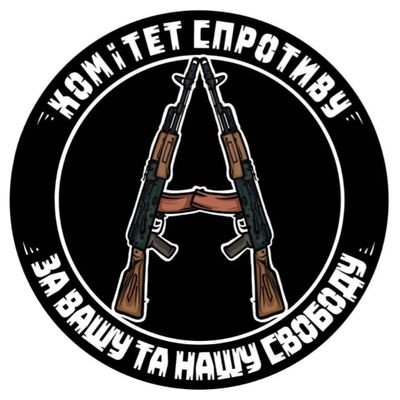
Can you give a breif summary of the fascist and antifascist movements in your country at the moment? How is it different from 10 years ago, and what is the prediction for the near future?
Well, the main fascist movement in Ukraine today is occupiers of the Russian state and its agents-satellites. This force represent authoritarian power fed with reactionary, chauvinist, imperialist ideology.
Of course, right-wing radicals exist also in Ukrainian society and therefore – “on Ukrainian side”. Currently they are represented a lot in the military, however despite of the myths spread by Kremlin propaganda right wingers in Ukraine by no way dominate and shape neither army nor society in general. So we need to take seriously occupiers as the dominant fascist threat.
At the same time wide range of Ukrainian right wingers starting with nationalists and up to real nazis are also on increase now. This is the misreaction on imperialist aggression. I.e. once again occupation policies of the Russian state are the main trigger of growing popularity of local nationalists and far-righters.
Antifascist camp is also not a monolyth here. We have a phenomenon of Soviet nostalgists and pro Putinists who mostly act as allies and try to instrumentalize a lot the brand of antifascism. This phenomenon is used by local right-wingers to discredit antifascism in general.
Real antifascists are represented by people of progressive and libertarian views. Our scene is less organized and numbered than our fascist vis-a-vis in this country, however in some big cities, such as, for example, Kiev, Kharkov, Lviv, etc. we manage to organize visible resistance against fascists.
As to historical perspectives – very big and dramatic point was Maidan uprising of 2014. Nationalists could promote well their agenda and gained influence within this popular uprising and because of that made a big step from marginality to mainstream. They developed even more using war situation and their active involvement in the fight against Russian State allowed them to secure certain place in Ukrainian society. However right-wingers failed to gain really considerable place in Ukrainian politics partly because they were corrupted by mainstream political forces and state institutions.
Maidan uprising was also a trigger of crisis within anti-authoritarian left. Because our movement could not effectively handle the challenge of massive popular uprising. However several years before full-scale invasion has started this February we saw sort of renaissance of the movement – new initiatives, events, actions and organizational efforts.
Full-scale war is probably the biggest challenge we have faced on our way. We should find the way to present and build ourselves politically. We are in process. And Resistance Committee is a part of this effort.

For swedish antifascists it’s clear that our countries neoliberal economic development has been going hand in hand with a new surge in recruits for the swedish fascist movement. Are there any similar
connections to be made between the rascism and fascism on the streets in your cities and the right-wing economic policies of the government in your country?
Far-right ideologies are widespread in “post-Soviet”, “post-Socialist” countries. The reasons are complex. Partly it is a reactions on decades of dictatorship of Soviet “communists”, partly of course it is the result of poverty in our countries.
Are you trying to develop new organizational forms and methods for confronting the new era of fascist movements, and if so, what role does physical violence as a tactic play for your group?
In a war situation we have to invent new organizational forms. Now there are two main branches: military and civil ones. In military branch, which the Resistance Committee is concentrated on, we contribute to the popular resistance against the imperialists. But our task is deeper than just to participate in a war. We try to find organizational forms within army structures to present ourselves as organized fighting libertarians – not just assimilate and disappear within military system. Among all other reasons – involvement in fight on the frontline is just necessary for any political force which wants to have a word in Ukraine today and tomorrow. It means to be together with the people in its ultimate resistance against the enslavement. Civil branch is concentrated on logistics support, humanitarian aid and media work. One of the most notable initiatives in civil branch is Solidarity Collectives.
In a war-torn country question of “physical violence” sounds absolutely differently. We are engaged in military conflict, which is completely another level or maybe even totally different thing than a street fight. So it is mere not about “physical violence”, but about legitimate force against extremely violent and oppressive enemy. As we see, it corresponds a lot with the concept of self-defense promoted by Kurdish
revolutionary movement.

Keeping the right-wing offensive going through Europe in mind, where does the antifascist movement in your country get it’s membership from (for example recruiting from working class neighbourhoods, from football culture etc)? How is the balance between newer younger people and older activists?
It seems, important role for recruiting is still played by punk/hardcore/vegan/straight edge, etc. subcultures. Antifascist and libertarian ideas are definitely attractive to young intellectuals resistant to nationalism and xenophoby. Also our natural allies are groups (especially of young people) who are subject for far right street violence (LGBT ppl, etc.). However all this looks like pre- full scale war picture. It seems for these 8 months we rather use our old reserves than recruit people. New ways are to be discovered.
Fascist and antifascist attitudes within countries and cities tend to be based on strictly geographical lines. In Sweden for example, the southern districts with the exception of Malmö is generally the most xenophobic, while the northern parts of the country tend to be more left-leaning. Do you have any fascist and antifascist strongholds within your cities?
Usually it is believed that Western part of the country is historically more conservative and nationalist. It is not that easy to say, how much it is actual for now. Especially after Maidan. Many right wing radicals are settled in big industrial cities which are located mostly in the East and South of the country. Even more important that in Ukraine exists ideology which sometimes mistaken as an “alternative” to Ukrainian nationalism – this is the mix of Soviet nostalgy and pro-Russian state sentiment which use the banner of antifascism but actually is also right wing and reactionary current. This ideology is usually attributed to Eastern and Southern cities, but it is shared by absolute minority of locals (we need to specify this not to let anybody space to speculate on legitimization of Russian intervention).
About neighborhoods there is one bright example – historical Podil neighborhood in Kiev. This is hipster/creative people/youth area of the capital city, with bars, rave, party points. It is an attraction place
for very different groups of youth and also a target for systematic fascist attacks. In 2021 there were a lot of confrontation against them. So, to some extent, Podil is if not stronghold but at least a node of antifascist resistance.
How does the cooperation between the antifascist groups and the broader left-wing movement look like? Are there any connections to parliamentary groups, unions, workplaces, environmental organizations etc?
We can say that here is the lack of connection and communication between different antifascist groups, however among us there are people involved in Feminist and Trade-unionist activities. At the moment we keep distance from parliamentary politics.

To what degree are antifascists in your country persecuted by the police and the legal system, in comparison to fascists? Are there any antifascists serving prison-time at the moment, and if so, how can antifascists in other countries help?
It seems legitimate to say that there is a lot of impunity for fascist criminal activities in Ukraine. However we can’t say that there is strong repressions against us as well. Ukrainian authorities tried to trace anarchists after certain direct actions (they made several interrogations and house raids), but unsuccessfully.
In 2019 they’ve deported Belarusian anarchist exile Alexander Franzkevich back to Belarus. In 2020 SBU (Ukrainian secret service) tried to deport another Belarusian anarchist exile – Alexey Bolenkov. But it was stopped by solidarity and kegal effort. It looks like there is no libertarian or antifascist prisoners in Ukraine at the moment.
What channels are you using to spread information? How can people come in contact with you?
Mostly we use Instagram: https://www.instagram.com/theblackheadquarter/
Telegram: https://t.me/theblackheadquarter
Twitter: https://twitter.com/resistancecua
Linktree, to keep our main publications together: https://linktr.ee/Theblackheadquarter
Finally, what gives antifascists in your area hope?
The biggest hope is given by disobedient and liberty-liking spirit of the people of Ukraine. There is a lot of spontaneous anarchism in local people. And as this war clearly shows there is a lot of will for resistance against oppression.
Revolutionary greetings,
Resistance Committee
***
Interview with Montréal Antifasciste
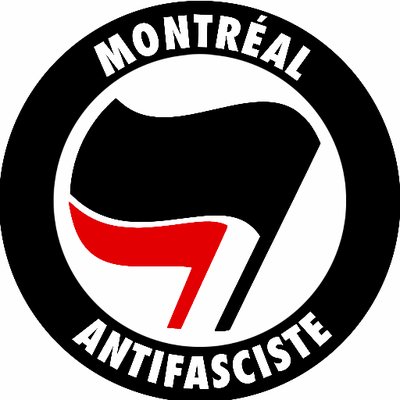
Can you give a brief summary of the fascist and antifascist movements in your country at the moment? How is it different from 10 years ago, and what is the prediction for the near future?
Speaking only of Québec here and below: several years ago the major far-right threat was the national populist organizations—i.e., populism, ultranationalism, anti-immigrant, Islamophobic—like La Meute and Storm Alliance, but a combination of factors—counterdemos, negative media attention, internal financial and sex scandals, poor security practice, and most importantly the victory of the current Québec government, the Coalition avenir Québec (CAQ), a mainstream populist party that fulfilled to a good degree their major demands: a ban on religious symbols in the public sector that largely affects Muslim women; reduced immigration (at least on paper), with a focus on francophone immigrants, an increased limitation of the rights of the large anglophone majority and any immigrants who would be more likely to integrate into anglophone culture than into francophone culture, the vociferous denial of systemic racism in Québec.
Currently there are a number of small neo-Nazi, fascist, and fascist-adjacent organizations, but their activity is largely online, with the occasional sticker campaign or banner drop. Their capacity for popular mobilization, at this point, is very limited.
Covid allowed some of the former leadership of far-right groups in decline to retool themselves around anti-protocol politics, with fairly successful mass mobilization for several years, but these groups have largely gone into decline as health measures have been lifted.
Under the right circumstances, any of these groups could make a comeback or new groups with similar politics could arise. The major issue is the relatively widespread right-leaning sentiment among the population at large that sometimes coalesces around anti-immigrant, Islamophobic, and hard nationalist sentiments. Although largely inactive, the speed with which people with these nebulous right-wing politics were mobilized around anti-protocol initiatives (primarily anti-masking and anti-vaxxing) indicates the risk we face.

What made you want to establish a whole new antifascist organization instead of joining the existing ones?
There was no obvious anti-fascist group to join. RASH, Jeune Garde, and the Sisterhood were groups that came out of and appealed to a particular demographic and were less likely to appeal to many of the people who wanted to be active in way that allowed for greater mainstream reach. In recent years, both Jeune Garde and the Sisterhood have disbanded in Quebec. RASH remains active, and we have very friendly and comradely relations and cooperate on a case by case basis. Our group came out of an initiative that involved a number of left-wing groups and individuals.
For swedish antifascists it’s clear that our countries neoliberal economic development has been going hand in hand with a new surge in recruits for the swedish fascist movement. Are there any similar connections to be made between the racism and fascism on the streets in your cities and the right-wing economic policies of the government in your country?
Neoliberalism, more specifically the crisis neoliberalism now finds itself in, certainly plays a role in the rise of the far-right, particularly given the lack of a cohesive left-wing or even social democratic response to this crisis. The fact is that the right has been more successful at offering an organized response to the current crisis than the left has been. Developing a more broad-based, cohesive, and organized response to the current economic crisis and the crisis faced by liberal democracy is a key component to resisting and reversing the rise of the right. At this point, any such response is rudimentary and fragmentary at best.

Are you trying to develop new organizational forms and methods for confronting the new era of fascist movements, and if so, what role does physical violence as a tactic play for your group?
As well as traditional forms, such as counterdemos, stickering/postering, propaganda at demonstrations and events, and public education, doxxing has become a major feature of our work.
While we would not initiate violence or suggest that anyone else do so, we would engage in active self-defense in the event of a street conflict. We would also proactively defend any event, venue, group, or individual threatened by the far right.
Furthermore, we would not criticize any comrades who did decide to initiate violence against members of the far right or to destroy their property, which in many cases would simply be preemptory self-defense, in any case.
Keeping the right-wing offensive going through Europe in mind, where does the antifascist movement in your country get its membership from (for example recruiting from working class neighbourhoods, from football culture etc)? How is the balance between newer younger people and older activists?
We began as a coalition of members of a number groups and interested individuals who began meeting in large assemblies, and over time settled into a distinct group. New members are recruited on an individual basis and must be known to at least one of our members who is able to vouch for them and their seriousness. Our group is made up of three generations of anti-fascists, with the oldest members tracing their politics back to the seventies, and the youngest members radicalized around more recent struggles, a student revolt that galvanized a popular uprising in 2012 being one key element. The groups we are most closely allied with are similarly diverse.

Fascist and antifascist attitudes within countries and cities tend to be based on strictly geographical lines. In Sweden for example, the southern districts with the exception of Malmö is generally the most xenophobic, while the northern parts of the country tend to be more left-leaning. Do you have any fascist and antifascist strongholds within your cities?
In Québec, the split is most pronounced between Montréal, the most multicultural city in the province and home to the most of the anglophone minority, and Québec City and the surrounding suburbs and small towns, where the highest concentration of right-wing activity has taken place. The split is less geographical than cultural, for reasons related to the history of colonialism and nationalism in Québec.
How does the cooperation between the antifascist groups and the broader left-wing movement look like? Are there any connections to parliamentary groups, unions, workplaces, environmental organizations etc?
Our closest allies are in groups doing work with immigrant and refugee communities, the anti-capitalist coalitions (mostly anarchist and left communist), and the anti-Zionist Jewish left. We also have close contact with other far-left organizations with whom some of our members work and collaborate. Our contact with political parties, unions, and workplace organizations is close to nonexistent, with the notable exception of the local IWW. Our cooperation with environmental organizations has been limited but positive.
To what degree are antifascists in your country persecuted by the police and the legal system, in comparison to fascists? Are there any antifascists serving prison-time at the moment, and if so, how can antifascists in other countries help?
Other than targeted over-policing during public counterdemos, there has been no apparent persecution of our members or other antifascists nor have we been illegalized in any way. To date, even the arrests in that context have been minor, resulting in fines. There are not currently any anti-fascists imprisoned in Québec for anti-fascist work.
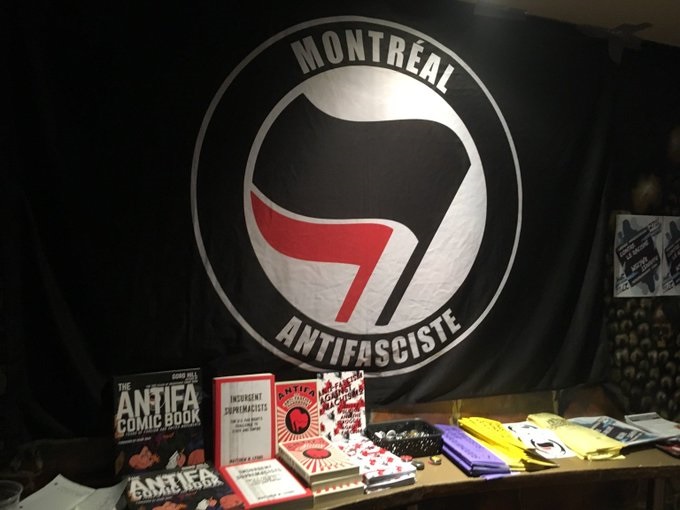
What channels are you using to spread information? How can people come in contact with you?
Website: http://montreal-antifasciste.info
Twitter: https://twitter.com/MontrealAntifa
Facebook: https://www.facebook.com/MontrealAntifasciste
And occasional distribution of propaganda at public demonstrations.
Finally, what gives antifascists in your area hope?
Anti-fascists have so far been able to quash serious street-level, far-right organizing in this province, and the anti-fascist/anti-racist milieu is going strong. At that level, the fascists have been losing consistently here since the nineties. Unfortunately, reactionary and populist nationalism is gaining ground in the mainstream, thanks to opportunistic politicians and a media landscape dominated by a populist media conglomerate and its large roster of conservative and reactionary columnists. This, we have next to no control over.
***
Interview with Rose City Antifa

Can you give a brief summary of the fascist and antifascist movements in your country at the moment? How is it different from 10 years ago, and what is the prediction for the near future?
The story of the last decade of the fascist and anti-fascist movement is the entrance of far-right ideology into mainstream political discourse, while their street formations have been held off by anti-fascist direct action. 10 years ago, the idea that a mainstream candidate for the Republican Party could express rebranded fascist ideology would have been difficult to imagine, but it is a regular occurrence today. At the same time, we anti-fascists have had excellent success in suppressing the far-right from being able to terrorize and harm people on a day to day basis. Anti-fascists have been the bulwark against far-right street action, especially in Portland. For the next ten years, I think the far-right will regroup from their defeat in the streets, and try to meld their entryist successes in the Republican Party with a formation better able to suppress anarchist, leftist, and unionist action outside the electoral space.
For swedish antifascists it’s clear that our countries neoliberal economic development has been going hand in hand with a new surge in recruits for the swedish fascist movement. Are there any similar connections to be made between the rascism and fascism on the streets in your cities and the right-wing economic policies of the government in your country?
The combination of years of gentrification, property hoarding by groups of investors, and massive inflation have led to surges in the amount of people experiencing houselessness. This particularly true in cities like Portland. As more people are forced onto the street, local neoliberal politicians have had massive support from more conservative elements and right-wing speakers to demonize those experiencing houselessness. In the most recent election, local politicians largely campaigned on “law and order” issues in ways that were really dehumanizing. This is related to other forms of right-wing violence and harassment of “others” including houseless populations and especially queer and trans communities.

Keeping the right-wing offensive going through Europe in mind, where does the antifascist movement in your country get it’s membership from (for example recruiting from working class neighbourhoods, from football culture etc)? How is the balance between newer younger people and older activists?
Our group has pulled its membership from a lot of different spaces, and maintains active connections to football (soccer) culture in our city, as well as the punk and anarchist scenes.
Fascist and antifascist attitudes within countries and cities tend to be based on strictly geographical lines. In Sweden for example, the southern districts with the exception of Malmö is generally the most xenophobic, while the northern parts of the country tend to be more left-leaning. Do you have any fascist and antifascist strongholds within your cities?
Not particularly; instead, the cities themselves are often bastions of anti-fascism. The dynamic of the past few years in the United States has been a demonization of cities as a whole for their imagined radicalism.
How does the cooperation between the antifascist groups and the broader left-wing movement look like? Are there any connections to parliamentary groups, unions, workplaces, environmental organizations etc?
We have had excellent and productive support from the broader left in our city. Broad coalitions have come together to oppose the far-right at specific events, and our voice is well-respected when we inform others on the left about threats from the far-right, as well as fascist attempts at entryism into leftist and anarchist spaces.






To what degree are antifascists in your country persecuted by the police and the legal system, in comparison to fascists? Are there any antifascists serving prison-time at the moment, and if so, how can antifascists in other countries help?
Anti-fascists in the USA, and especially Portland, have faced disproportionate legal repression by the police. Fascists have collaborated heavily with the police in repressing anti-fascists. Anti-fascists have been convicted and people like Gage Halupowski have spent or are spending multiple years in jail for actions against the far-right. Sending letters to imprisoned anti-fascists is one of the most basic ways to help, as well as buying books or donating to commissary funds.
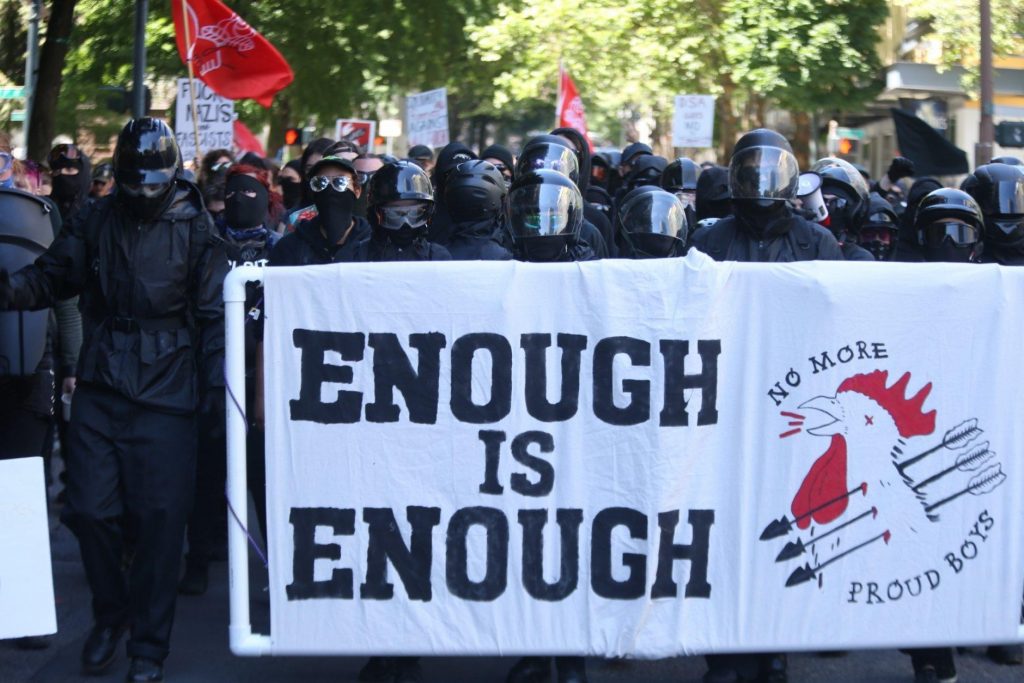
What channels are you using to spread information? How can people come in contact with you?
We depend on our own website, rosecityantifa.org, to compile our information on fascist, white nationalist, and white supremacist organizers. For us, having a website is absolutely crucial, though extra care must be taken when setting it up and deciding what materials to host. We use social media, including services like Mastodon and Twitter, to distribute that information. We also do leafletting, wheatpasting, and zine distribution to get our information out to our community.
Finally, what gives antifascists in your area hope?
We are given hope by the memory of the George Floyd Uprising. Despite the fact that reactionaries around the country have tried to turn back the clock or erase the memory of this, we remember that a militant uprising of millions of people across the United States against racism and white supremacy did occur.
General Inquiry: [email protected]
Tips: [email protected]
Voicemail tips: (971) 533-7832
https://twitter.com/RoseCityAntifa
Mastodon: https://kolektiva.social/@RoseCityAntifa
https://rosecityantifa.org/
***
Interview with AFA Copenhagen

Can you give a breif summary of the fascist and antifascist movements in your country at the moment? How is it different from 10 years ago, and what is the prediction for the near future?
The Danish fascist movement has been under big development in the past ten years. The “nazi-hooligan” groups have almost disappeared and have been replaced with groups that are more social media-oriented. Some still use the same rhetorics while others have a more ”academic” and Identitarian approach to the matter. Islam is the big focus of most of the right-wing groups, alongside queerphobia and racism. The Anti-fascist movement have been under development too. We have been working on macho-culture in our communities and recently we have started working more on racism and white privilege internally.
The future struggle of the anti-fascist movement is probably to make sure that we can keep up with the new brand of fascism that is becoming a more and more accepted part of public politics.
For swedish antifascists it’s clear that our countries neoliberal economic development has been going hand in hand with a new surge in recruits for the swedish fascist movement. Are there any similar connections to be made between the rascism and fascism on the streets in your cities and the right-wing economic policies of the government in your country?
The danish political climate is in many ways similar to that in Sweden. We too see the correlation between mainstream politics and far-right activism. This has been going on for many, many years, especially the last decade. As metioned before, the rise of the ”social media fascist” is happening as deeply conservative rhetorics and neoliberal economics are getting popular in parliament and the general public.

Fascist and antifascist attitudes within countries and cities tend to be based on strictly geographical lines. In Sweden for example, the southern districts with the exception of Malmö is generally the most xenophobic, while the northern parts of the country tend to be more left-leaning. Do you have any fascist and antifascist strongholds within your cities?
While the right-wing parties are mostly popular in the rural areas of Denmark, especially southern and western Jutland, the fascist groups actually center their activities around the larger cities such as Copenhagen, Aarhus and Aalborg.
The same goes for the left wing and anti-fascist movement – we also center around the big cities.
Are you trying to develop new organizational forms and methods for confronting the new era of fascist movements, and if so, what role does physical violence as a tactic play for your group?
As the fascist movement develops, we have to take a look at our strategies and work on our methods. Recruiting new activists is a great resource, because it gives us a fresh pair of eyes, that help us from getting stuck in old ways that may have proven to be ineffective. We use methods that cover both intellectual work, such as making political analyses, and street-work, such as militant counter-demonstrations.
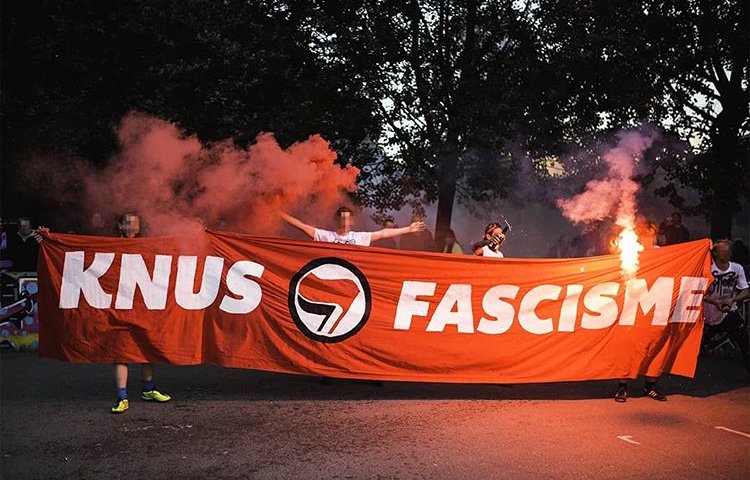
Keeping the right-wing offensive going through Europe in mind, where does the antifascist movement in your country get it’s membership from (for example recruiting from working class neighbourhoods, from football culture etc)? How is the balance between newer younger people and older activists?
Our activists come from different backgrounds. This includes youth-parties, workers unions and student unions as well as other autonomous groups. The common factor is of course that everyone is anti-racist, anti-ableist, anti-classicist, queerfeminist and revolutionary. We have experienced that recruiting from a broader spectrum gives different perspectives and skills, that really benefit the anti-fascist work. Activists tend to be younger, often in their late teens, twenties and early thirties. The work is pretty time consuming and doesn’t mix well with having kids for example. However, we try to make space for people in different walks of life and prevent burn-out. This means that we are blessed with a lot of older activists that support and help the way they can.
How does the cooperation between the antifascist groups and the broader left-wing movement look like? Are there any connections to parliamentary groups, unions, workplaces, environmental organizations etc?
The groups on the radical left wing cooporate a lot, we often share experiences and do events with other groups. The cooperation between us and the broader left wing and parliament is more loose, based on personal connections and rarely official.
To what degree are antifascists in your country persecuted by the policeand the legal system, in comparison to fascists? Are there any antifascists serving prison-time at the moment, and if so, how can antifascists in other countries help?
We are pretty lucky, compared to other countries when it comes to dealing with police and prosecutors. We all experience a certain amount of harassment and oppression, but we haven’t had any major trials or sentences among activists in the last couple of years. But the new conservative sentiment in parliament is also influencing the judicial system and the police, so we migth see a change in attitude.
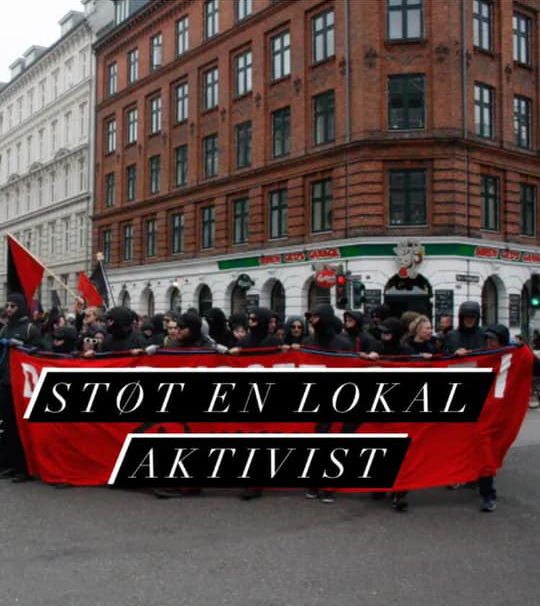
What do you want and what can you say about your research and gathering intel of the fascist movement?
Research is a key element in our movement. In Denmark there is an organization, called Redox, whose sole focus is researching the far-right. Their work gives us great insight into the structure of the fascist groups and how they work. This enables us to anticipate their activities and asses the level of threat.
What channels are you using to spread information? How can people come in contact with you?
Like everyone else, we use Instagram (@afakbh) and Facebook (@Antifascistisk Aktion). We also have a service called Antifa Update that allows us to send direct messages to people if there is a demonstration or nazi activities going on.
If you want to get in touch with us you can message our SoMe accounts or email [email protected]. Last but not least we have a 24h hotline (+45 21843432) where people can call or text us if they notice any fascist activity in Denmark.
Finally, what gives antifascists in your area hope?
Covid was a rough period for us. It was hard to do community oriented activities in a safe manner and it gave a feeling of loneliness and beeing torn apart. But coming out on the other side and seeing all sorts of political groups working together on refugee solidarity, housing, feminism, community care and anti-racism really gives a sense of moving towards actual political change, and that gives us renewed hope and energy to keep the anti-fascist fight going strong.
***

